In this guide, we will walk through how to patch a HPE Synergy Blade Chassis including all the shared infrastructure components
Important – By continuing you are agreeing to the disclaimer here
Pre Checks
HPE recommend the follow order of upgrades as a general rule of thumb, which can be found here
Here is a list of the currently support Composer/Image Streamer by HPE
1
Check the Perquisites HPE have, this runs through the typical order listed below, but also more Edge cases, the HPE guide is here
For example, if you are a few years out of date, you may not be able to make a large jump on the composer/firmware while maintaining a supported firmware, which is key
If you take a system on Composer 6.3 and firmware 2021.01 and you want to move to the latest LTS Composer on 6.60.6 with firmware 2023.10, your current firmware is not listed anyway as supported on Composer 6.60.6, so its not recommended to upgrade the Composer first in this instance
Instead, update the firmware to 2022.02, this is supported for Composer 6.3, your current version, and while its reach end of support for Composer 6.60.6, it is compatible, so here you would update the firmware first to 2022.02, then the Composer to 6.60.5, then the firmware to 2023.10 then the composer to 6.60.6
While its most likely fine to upgrade the composer directly to 6.60.6, at the time of writing, its not listed as expressly supported on the upgrade matrix here
2
For a general upgrade you would first upgrade the Composer, OneView, ensuring you take a backup first
There is likely to be two modules on the Synergy system, so remember to do both, the standby Composer will be done first, followed by the active
3
Update the Image Streamer, you may or may not have this, the latest release is 6.4 and has been deprecated for since the end of 2022, the Composer has two main supported releases, the Mainline which is frequently updated and the LTS support
LTS is on 6.60.6 as of Feb 2024 and the Mainline is on 8.7
Composer 8 was the last version to support the Image Streamer, so if you are on higher than this, you shouldnt have one, if you are on lower you may
4
Update the firmware, the best order here is shared infrastructure then blade firmware
You can update the firmware together or separately as well as in serial and parallel updates
HPE recommend, for a non disruptive update of interconnects, choosing Orchestrated as the type of firmware activation for Interconnect Activation
You should take care here with the shared infrastructure, this will update various chassis firmware shared by all blades, so there is a risk of taking the chassis offline if not done correctly
Firmware on this list includes the IOMs, so make sure everything is wired with redundancy in mind and that you have at least 2 IOMs, as if it isnt redundant, or you have 1 IOM, it will get rebooted as part of an update, and it will take the networking out for the blades underneath
5
Update the firmware for the blades using the Synergy SPP with a server profile, HPEs guide can be found here
6
Update the host software, Windows/ESXi updates
Composer
HPEs documentation for the composer is here
You can check if you have dual redundant composers from Settings/Appliance

When updating the Composer you need to check the upgrade path you are going to take and ensure its a valid path to avoid any issues
For 4 –> 5 upgrade paths

For 5 –> 6 upgrade paths

For 6 –> 8 upgrade paths


For example, I have a Synergy system running Composer 6.3 and I want to go to the LTS version 6.60.6
From paths above I can go from 6.3 to 6.60.5, and then from 6.60.5 to 6.60.6
While you probably can go direct from 6.3 to 6.60.6 since its a minor version change, its not explicitly stated that you can, so I would always recommend playing it safe
First step is to backup the Composer
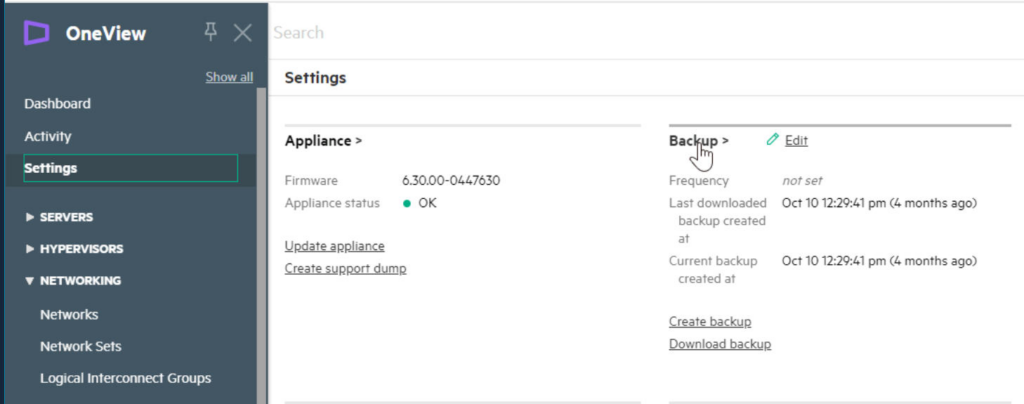
Create a backup

And download to the browser
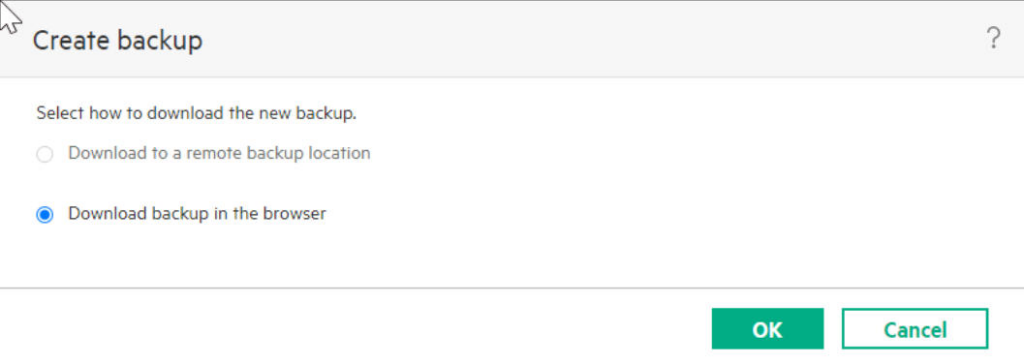
I would also create an ESXi backup using the following by an SSH session to the nodes
vim-cmd hostsvc/firmware/sync_config
vim-cmd hostsvc/firmware/backup_config
To update the appliance go to Settings/Appliance

Then update appliance

This will give this menu

Browse for the bin file for the Composer version you wish to update on and click upload
You will then get a screen like this while the file is uploading

Once thats uploaded, the process is to update the standby appliance, then fail over to that, and update the remaining appliance
Click update to continue
Its advised not to perform any tasks in OneView at this time

You will then be brought back to the Appliance menu where you can track the update to the standby Composer

Image Streamer
For updating the Image Streamer, its only supported up to Composer 8, after that its not supported, so if you need the Image Streamer or dont want to decommission an existing one, you’ll need to stick with an LTS release, it has been deprecated since Dec 2022
As of Feb 2024, HPE recommend Composer 8.60.01 or 8.7 for the latest, or LTS 6.60.6
Older version down to Composer 8.1 are supported by HPE, but they dont come with the Image Streamer, so if you want support you either decommission it, if you have it, and go up to, ideally 8.7 or stick with the LTS release if it includes it
To check if you have an Image Streamer go to Appliance in OneView, then OS Deployment Servers, if you dont, then you dont have an Image Streamer
Information from HPE on how to update the image streamer can be found here, as my example didnt have one, I dont have any detailed information on the process, but ideally you want to decommission this
Shared Infrastructure
Updating the shared Infrastructure consists of the Frame Link Modules, Interconnect Modules/IOMs, and drive enclosures, if you have them, as they are common to all of the blades
HPE recommend Orchestrated as the type of firmware activation for Interconnect Activation but take care to check for any warnings under the Logical Enclosures Screen, HPEs information is here
HPE’s documentation on the shared infrastructure updates is here
To start the shared infrastructure firmware update go to the Logical Enclosure

To upload the SPP firmware, go to Firmware/Firmware Bundles and Add Firmware Bundle

Browse and select the firmware, and click ok

Once thats uploaded it should look like this

To kick off the shared Infrastructure updates we need to go to the Logical Enclosure

Then firmware update

Select the new SPP baseline, and Shared Infrastructure, we dont want to do the blades yet
You will then get an overview of thats going to be updated
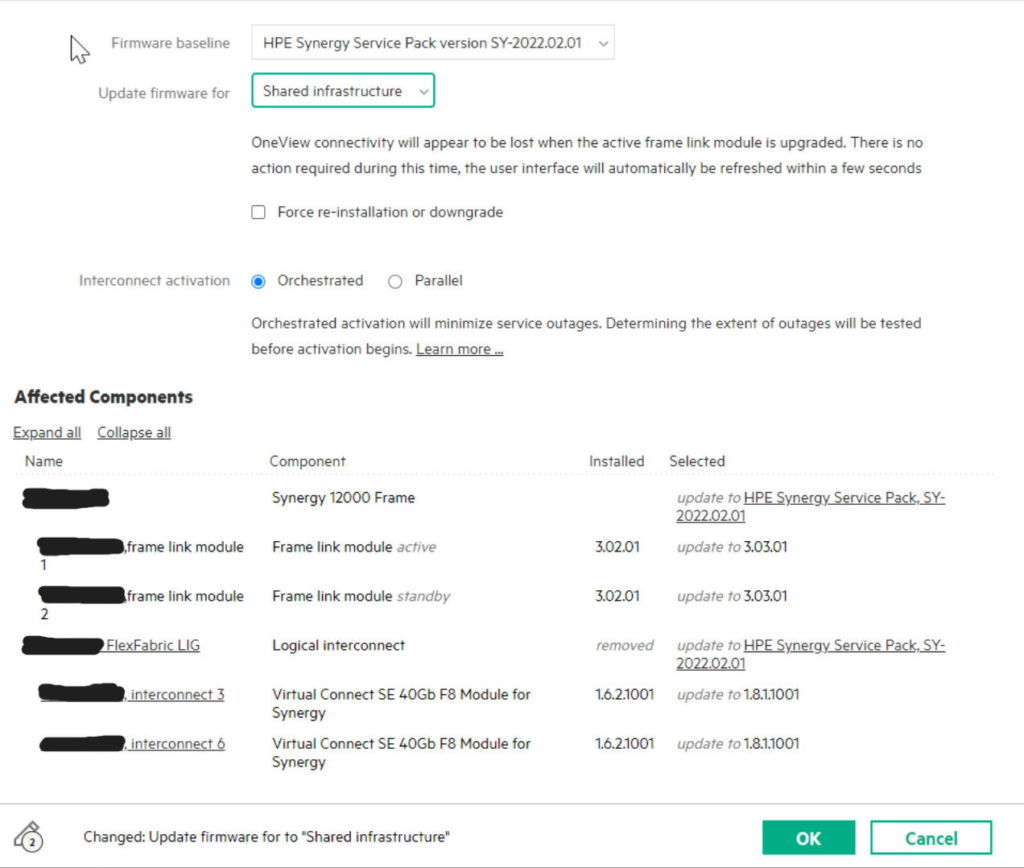
The system will check for any possible outages

It will tell you if there are any issues, if not it will proceed with the update
While updating it will stage to the IOMs at the same time, but activate the firmware, by rebooting, one at a time

Once its done it should look all green

Blade Infrastructure
Updating the blade firmware depends on your setup, for my example I have each blade with its own profile pulling from a template


Firstly we want to update the Template SPP, as thats what all the blades are pulling from
Edit the template

Update the SPP
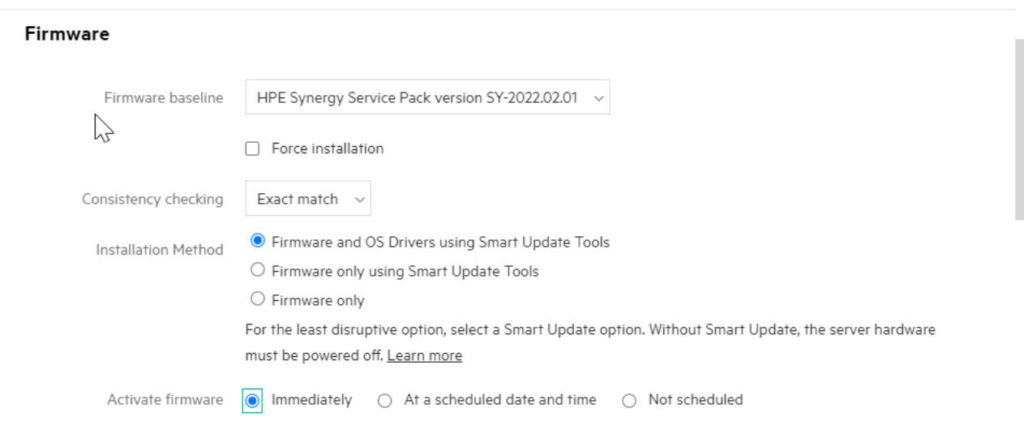
This will cause all the blades to become inconsistent and require manually updating to put the on the latest SPP
The servers should be in maintenance mode in ESXi, the iLO will get updated and the patches should get staged to the host if SUT is in stage only, but it may be in auto deploy
Once thats set, active the blade and stage the updates

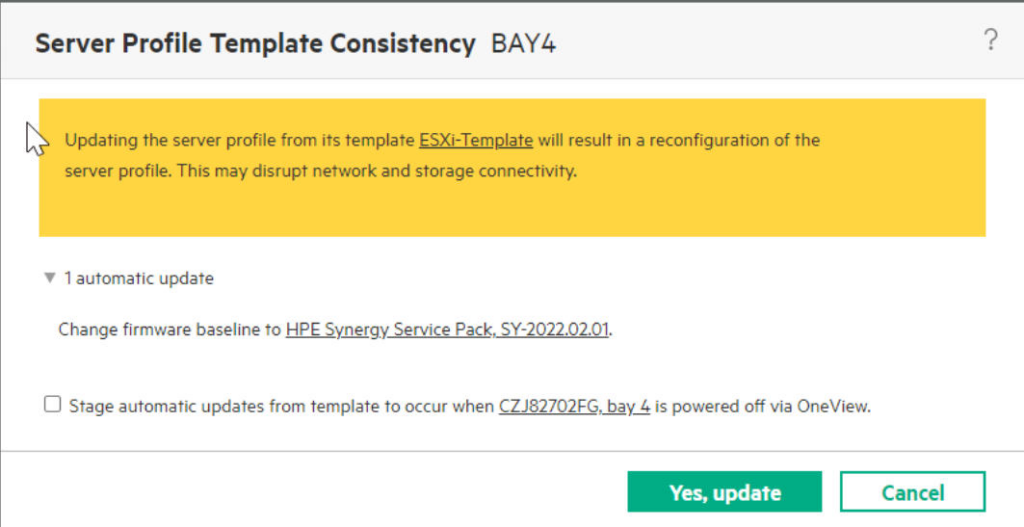
This will update the iLO
SUT will be configured to either Stage updates only, or auto deploy, if its set to deploy it will automate the rest, if not, OneView will tell you that its waiting on you
Eg
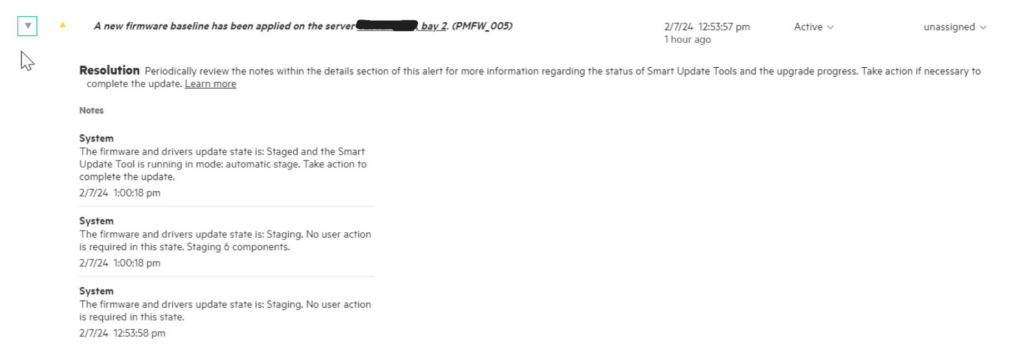
At this point you need to take action once its staged, SSH into the ESXi host as SUT is installed and run the following to apply and reboot the server
sut -deployreboot
When SUT has deployed all the updates it will tell you to reboot

Or it may reboot its self

Reboot the server with
sut -activate
Once it boots up you may need to give it 5 for OneView to register its done
It may alert saying a package couldnt be updated, SSH back in and re run the SUT command to install any failed packages
Errors
Symantec Class 3 Secure Server Certificate Expired
If you have this error on your Synergy then you can remove the certificates as they are no longer needed

HPE have some more information here
